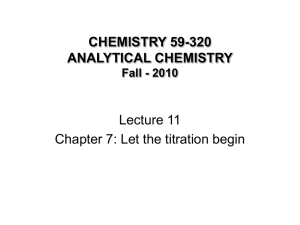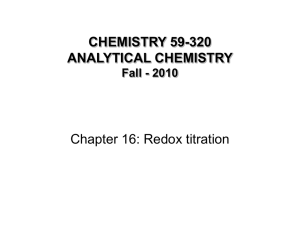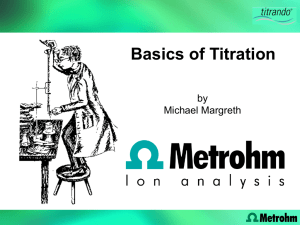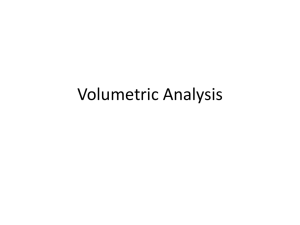Titration
advertisement
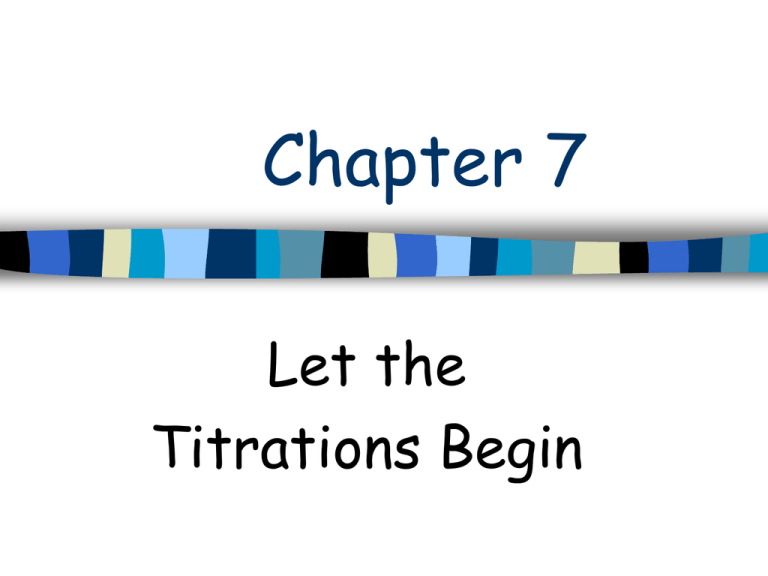
Chapter 7 Let the Titrations Begin Titration Titration – A procedure in which one substance (titrant) is carefully added to another (analyte) until complete reaction has occurred. • The quantity of titrant required for complete reaction tells how much analyte is present. Volumetric Analysis – A technique in which the volume of material needed to react with the analyte is measured Titration Vocabulary Titrant – The substance added to the analyte in a titration (reagent solution) Analyte – The substance being analyzed Equivalence point – The point in a titration at which the quantity of titrant is exactly sufficient for stoichiometric reaction with the analyte. Titration Vocabulary End point – The point in a titration at which there is a sudden change in a physical property, such as indicator color, pH, conductivity, or absorbance. Used as a measure of the equivalence point. Indicator – A compound having a physical property (usually color) that changes abruptly near the equivalence point of a chemical reaction. Titration Vocabulary Titration error – The difference between the observed end point and the true equivalence point in a titration Blank Titration – One in which a solution containing all reagents except analyte is titrated. The volume of titrant needed in the blank titration should be subtracted from the volume needed to titrate unknown. Titration Vocabulary Primary Standard – A reagent that is pure enough and stable enough to be used directly after weighing. Then entire mass is considered to be pure reagent. Standardization – The process whereby the concentration of a reagent is determined by reaction with a known quantity of a second reagent. Titration Vocabulary Standard Solution – A solution whose composition is known by virtue of the way it was made from a reagent of known purity or by virtue of its reaction with a known quantity of a standard reagent. Direct Titration – One in which the analyte is treated with titrant, and the volume of titrant required for complete reaction is measured. Titration Vocabulary Back Titration – One in which an excess of standard reagent is added to react with analyte. Then the excess reagent is titrated with a second reagent or with a standard solution of analyte. Titration Calculations Titration Calculations rely heavily on the ability to perform stoichiometric calculations. Examples Titration Calculation Examples How many milligrams of oxalic acid dihydrate, H2C2O4 . 2H2O (FM = 126.07), will react with 1.00 mL of 0.0273 M ceric sulfate (Ce(SO4)2) if the reaction is: H2C2O4 + 2Ce4+ 2CO2 + 2Ce3+ + 2H+ Titration Calculation Examples A mixture weighing 27.73 mg containing only FeCl2 (FM = 126.75) and KCl (FM = 74.55) required 18.49 mL of 0.02237 M AgNO3 for complete titration of the chloride. Find the mass of FeCl2 and the weight percent of Fe in the mixture. Titration Calculation Examples The calcium content of urine can be determined by the following procedure – Step 1. Ca2+ is precipitated as calcium oxalate in basic solution: Ca2+ + C2O42- + H2O Ca(C2O4) . H2O(s) – Step 2. After the precipitate is washed with ice-cold water to remove free oxalate, the solid is dissolved in acid, which gives Ca2+ and H2C2O4 in solution. – Step 3. The dissolved oxalic acid is heated at 60oC and titrated with standardized potassium permanganate until the purple end point of the following reaction is observed: 5H2C2O4 + 2MnO4- + 6H+ 10CO2 + 2Mn2+ + 8H2O Titration Calculation Examples Standardization: Suppose that 0.3562 g of Na2C2O4 is dissolved in a 250.0 mL volumetric flask. If 10.00 mL of this solution require 48.36 mL of KMnO4 solution for titration, what is the molarity of the permanganate solution? Calcium in a 5.00-mL urine sample was precipitated, was redissolved, and then required 16.17 mL of standard MnO4- solution. Find the concentration of Ca2+ in the urine Titration Calculation Examples A solid mixture weighing 1.372 g containing only sodium carbonate and sodium bicarbonate required 29.11 mL of 0.734 M HCl for complete titration: Na2CO3 + HCl 2NaCl(aq) + H2O + CO2 NaHCO3 + HCl NaCl(aq) + H2O + CO2 Find the mass of each component of the mixture. Titration Calculations Kjeldahl Nitrogen Analysis – Digest the organic compound in boiling H2SO4 to convert Nitrogen to NH4+ • Hg, Cu, or Se will catalyze the digestion process • Raise the b.p. of H2SO4 (338oC) by adding K2SO4 to increase the rate of the reaction Titration Calculations Kjeldahl Nitrogen Analysis – Treat the ammonium compound with base and distill as ammonia into a standard acidic solution • NH4+ + OH- NH3(g) + H2O • NH3 + H+ NH4+ – The moles of acid consumed equal the moles of NH3 liberated • H+ (HCl) + OH-(NaOH) H2O Titration Calculation Examples A typical protein contains 16.2 wt% nitrogen. A 0.500-mL aliquot of protein solution was digested, and the liberated ammonia was distilled in 10.00 mL of 0.02140 M HCl. The unreacted HCl required 3.26 mL of 0.0198 M NaOH for complete titration. Find the concentration of protein (mg protein / mL) in the original sample. Spectrophotometric Titrations One in which absorption of light is used to monitor the progress of the chemical reaction Spectrophotometric Titration Example 2Fe3+ + Apotransferrin (Fe3+)2transferrin – Apotransferrin is clear – (Fe3+)2transferrin is red – Absorption increases as a result of red from Iron attachment to the apotransferrin • Saturated protein – no further color change – absorption levels off • Extrapolated intersection is the equivalence point Spectrophotometric Titration Example Construction of Graph – When constructing the graph of the absorbance values versus the concentration of Fe3+ you must take in account the dilution factor – Corrected absorbance = (total Volume / initial Volume)(observed absorbance) Corrected Absorbance Calculations The absorbance measured after adding 125 L of ferric nitrilotriacetate to 2.000 mL of apotransferrin was 0.260. Calculate the corrected absorbance that should be plotted. Titration Curve Titration Curve is a result of plotting p[X] (p[X]=-log [X]) versus the concentration of the titrant Precipitation Titration – Concentration of analyte, concentration of titrant and the Ksp influence the sharpness of the endpoint Acid-Base reaction and OxidationReduction reactions – Have to calculate the theoretical endpoint to determine the indicator to be used Precipitation Titration Curve Example – AgI(s) formation – Ag+ + I- AgI(s) • Reverse of the Ksp reaction for the dissociation of AgI(s) so the K for this reaction equal 1/Ksp[AgI(s)] = 1.2 X 1016 – Large K value means that the equilibrium lies to the right for this reaction – Each aliquot addition of Ag+ titrant reacts virtually entirely to form AgI(s) Precipitation Titration Curve Titration Curves typically exhibit 3 distinct regions for a single titrant reacting with a single analyte. – Before the Equivalence Point – At the Equivalence Point – After the Equivalence Point Precipitation Titration Curve Before the Equivalence Point – Example of AgI(s) formation • Most of the [Ag+] reacts entirely to give AgI • p[Ag+] = – the amount of Ag+ left in solution » The amount of I- present » From Ksp determine the amount of Ag+ present Precipitation Titration Curve At the equivalence point – Stoichiometric amount of Ag+ as I- so all has precipitated out as AgI(s) • Regular Ksp calculations Precipitation Titration Curve After Equivalence Point – [Ag+] is determined by the Ag+ present after the equivalence point with the dilution factor taken into account Precipitation Titration Curve Equations Calculate the Volume of Titrant needed to reach equilibrium MTVT = (Mole ratio)MAVA Before the Equivalence Point [A] = (Fraction of Titrant Remaining)(M of Analyte)(Original Volume of solution / Total Volume of solution) [T] = Ksp / [A] pT = -log[T] Precipitation Titration Curve Equations At Equivalence Point [A][T] = Ksp Calculate like in section 6-3 After the Equivalence Point [T] = (Original Concentration of Titrant)(Volume of excess Titrant / Total Volume of Solution) pT = -log[T] Precipitation Titration Curve Example 25.00 mL of 0.1000 M I- was titrated with 0.05000M Ag+. Ag+ + I- AgI(s) The solubility product for AgI is 8.3 x 10-17. Calculate the concentration of Ag+ ion in solution (a) after addition of 10.00 mL of Ag+; (b) after addition of 52.00 mL of Ag+; (c) at the equivalence point. Precipitation Titration Curve Example 25.00 mL of 0.04132 M Hg2(NO3)2 was titrated with 0.05789 M KIO3. Hg22+ + 2IO3- Hg2(IO3)2(s) The solubility product for Hg2(IO3)2 is 1.3 x 10-18. Calculate the concentration of Hg22+ ion in solution (a) after addition of 34.00 mL of KIO3; (b) after addition of 36.00 mL of KIO3; (c) at the equivalence point. Precipitation Titration Curve Example Consider the titration of 50.00 mL of 0.0246 M Hg(NO3)2 with 0.104 KSCN. Calculate the value of pHg22+ at each of the following points and sketch the titration curve: 0.25VT 0.5VT 0.75VT 1.05VT 1.25VT Titration Curve Shape 1:1 Stoichiometry of Reagents – Equivalence point is the steepest point of a curve • Maximum slope • An inflection point Other Stoichiometries – The curve is not symmetric about the equivalence point – The equivalence point is not at the center of the steepest section of the curve The less soluble the product, the sharper the curve around the equivalence point Titration Curve Shape Titration of a Mixture The less soluble product forms first If there is sufficient difference in solubility of products – First precipitation is nearly complete before the second one begins • Separation by precipitation (section 6-5) – Coprecipitation • Alters the expected endpoints Titration of a Mixture Example Chapter 7 - Homework Problems – 2, 4, 8, 11, 12, 18, 22, 23, 28


